
Lancaster is a village in Erie County, New York, United States. As of the 2010 census, the village population was 10,352. It is part of the Buffalo–Niagara Falls Metropolitan Statistical Area.

Lancaster Municipal Building is a historic municipal building in Lancaster, Erie County, New York. It is also known as Lancaster Village Hall, and was built in 1940.

The Downtown Albany Historic District is a 19-block, 66.6-acre (27.0 ha) area of Albany, New York, United States, centered on the junction of State and North and South Pearl streets. It is the oldest settled area of the city, originally planned and settled in the 17th century, and the nucleus of its later development and expansion. In 1980 it was designated a historic district by the city and then listed on the National Register of Historic Places.
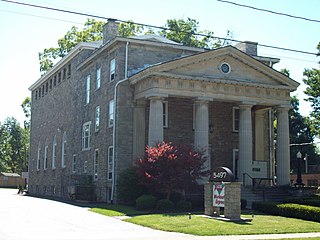
Depew Lodge No. 823, Free and Accepted Masons is a historic building located at Lancaster in Erie County, New York. It is a locally distinctive example of the Neo-Classical Revival style of architecture. Built between 1916 and 1919 as a meeting hall for the local Masons. Today, it is used as a commercial office building.
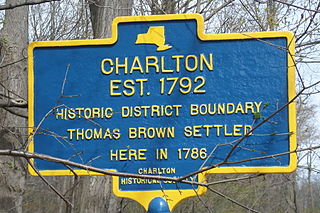
Charlton Historic District is a 123-acre (50 ha) national historic district located at the hamlet of Charlton, town of Charlton in Saratoga County, New York. The listing included 37 contributing buildings and one other contributing structure. The district dates to 1787 and includes notable Greek Revival and Italianate architecture.

Dawson Historic District is a national historic district located at Dawson, Fayette County, Pennsylvania. The district includes 107 contributing buildings in the central business district and surrounding residential areas of Dawson. The oldest building is the log Cochran House. Most of the contributing buildings were built between 1870 and 1940, and are representative of a number of popular architectural styles including Bungalow / American Craftsman, Classical Revival, and Queen Anne. Other notable buildings include the Dawson Baptist Church, James Cochran House, W. H. Cochran House (1880s), Rist House (1880s), First National Bank (1897), and Masonic Hall. The Cochran Memorial United Methodist Church is located in the district and listed separately.
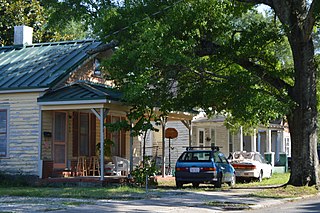
West Selma Historic District is a national historic district located at Selma, Johnston County, North Carolina. It encompasses 217 contributing buildings, 1 contributing site, and 1 contributing structures in predominantly residential section of Selma. It includes notable examples of Queen Anne, Gothic Revival, Moderne, and Bungalow / American Craftsman style architecture and buildings dating from about 1880 to 1961. Located in the district is the separately listed Nowell-Mayerburg-Oliver House and William E. Smith House. Other notable buildings include the Edgerton Memorial Methodist Episcopal Church, Abdalla House, Dr. Joshua W. Vick House, Stella and William H. Etheridge House, Dr. R. Marvin Blackmon House, Samuel P. Wood House (1935), Janie and C. E. Kornegay House (1923), Selma Presbyterian Church, St. Gabriel's Episcopal Church/Vernon Wiggs House, and Pepsi Bottling Company.
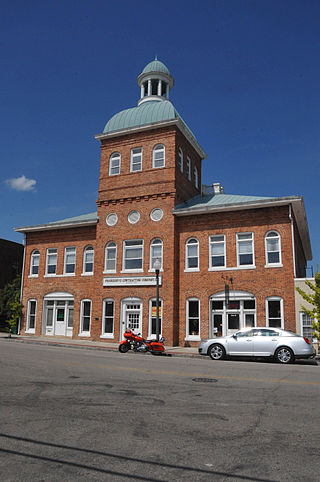
Downtown Sanford Historic District is a national historic district located at Sanford, Lee County, North Carolina. It encompasses 53 contributing buildings in the central business district of Sanford. The district includes notable examples of Colonial Revival, Tudor Revival and Art Deco style architecture, with buildings largely dated between about 1895 to 1930. Located in the district are the separately listed Railroad House and Temple Theatre. Other notable buildings include the Sanford Buggy Company, McCracken Building, Passenger Depot, City Hall, Coca-Cola Bottling Company, Masonic Lodge, Makepeace Building (1924), Wilrick Hotel (1925), Bowers Building, Cole Pontiac Building, Hubbards Shoe Store (1926), Carolina Hotel (1930), and former U. S. Post Office.

The Siloam Springs Downtown Historic District encompasses the historic downtown area of Siloam Springs, Arkansas. The district is roughly bounded by University Street, Broadway, and Sager Creek, with a few buildings on adjacent streets outside this triangular area. This business district was developed mainly between about 1896, when the railroad arrived, and 1940, and contains a significant number of buildings dating to that period. It also includes Siloam Springs City Park, the location of the springs that gave the city its name. Notable buildings include the First National Bank building, a c. 1890 Romanesque Revival building, and the c. 1881 Lakeside Hotel, which is one of the city's oldest commercial buildings.

Central Avenue Historic District is a national historic district located at Lancaster in Erie County, New York. The district encompasses 17 contributing buildings in the central business district of the village of Lancaster. The district includes a variety of residential, commercial, and government buildings built between about 1860 and 1940. It includes notable examples of Italianate and Colonial Revival style architecture. Notable buildings include the Lancaster Town Hall and Opera House, Former Post Office, Cushing Block, and Potter-Eaton House.
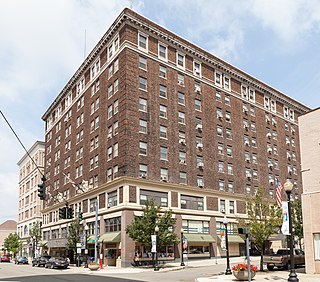
Jamestown Downtown Historic District is a national historic district located at Jamestown in Chautauqua County, New York. The district encompasses 103 contributing buildings in the central business district of Jamestown. The district developed between about 1873 and 1956, and includes buildings in a variety of architectural styles including Italianate, Gothic Revival, Second Empire, Romanesque Revival, Classical Revival, Renaissance Revival, and Art Deco. Located in the district is the separately listed Wellman Building. Other notable buildings include the Arcade Building (1898), Odd Fellows Lodge (1914), Bank of Jamestown, Hotel Samuels (1910), Hotel Jamestown (1924), Chautauqua School of Nursing (1911), Jamestown Telephone Company (1930), Maddox Building (1933), First National Bank (1953), Pennsylvania Gas Company building, Chautauqua National Bank (1956), Palace Theatre, Allen's Opera House, and the former Broadhead Worsted Mills.
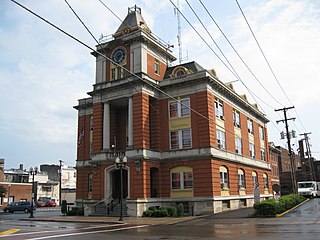
Geneva Downtown Commercial Historic District is a national historic district located at Geneva, Ontario County, New York. It encompasses 83 contributing buildings in the central business district of Geneva. They were built between about 1840 and 1940, and include notable examples of Greek Revival, Italianate, Romanesque Revival, Colonial Revival, and Art Deco style commercial architecture. Located in the district are the separately listed Farmers and Merchants Bank, Smith's Opera House, and United States Post Office. Other notable buildings include the Prouty Block (1876), YMCA (1902), Wheat Building (1904), Guard Building, Geneva City Hall, Odd Fellows Building (1884-1890), and Kresge Building (1928).

Rockland Road Bridge Historic District is a national historic district located at Piermont in Rockland County, New York. The district encompasses 12 contributing buildings and 8 contributing structures in the village of Piermont. It developed between about 1785 and 1940, and includes representative examples of Federal, Greek Revival, Italianate, and Second Empire style architecture. Located in the district are the separately listed William Ferdon House, Haddock's Hall, and the Rockland Road Bridge. Other notable buildings and structures include the Sparkill Pump House and Dam, "Protection Engine Company", and The Mine Hole.

East Hill Historic District is a national historic district located at Springville in Erie County, New York. The district encompasses 59 contributing buildings and 2 contributing objects in the original residential district of the village of Springville. The district includes a variety of residential buildings built between about 1835 and 1935. It includes notable examples of Greek Revival, Italianate, Queen Anne, Colonial Revival, and Bungalow / American Craftsman style architecture. Notable buildings include the George E. Crandall House / Warner Museum, Frank O. Smith House, C.J. Shuttleworth House, Morris Hall House (1892), and Inez Wiggins House.
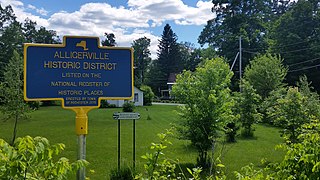
Alligerville Historic District is a national historic district located at Alligerville, Ulster County, New York. It encompasses 81 contributing buildings, 5 contributing sites, and 8 contributing structures in the hamlet of Alligerville. It developed after 1828 around Lock 21 on the Delaware and Hudson Canal and includes notable examples of Greek Revival, Gothic Revival, and Italian Villa architecture. Notable contributing resources include the John & Catrina Alliger House, Reformed Dutch Church of the Clove Chapel, Ira Brodhead House, John Forbes Hotel, Alligerville Post Office, Thomas S. Schoonmaker Farm (1830), Union Free District No. 1 School, Canal Outbuilding, Hall-Latinville Summer Cottages, and Hall-Barrett Summer Cottage.
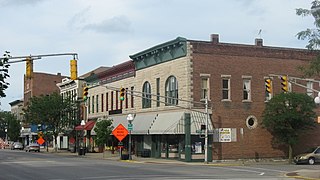
North Vernon Downtown Historic District is a national historic district located at North Vernon, Jennings County, Indiana. It encompasses 80 contributing buildings and 1 contributing structure in the central business district of North Vernon. The district developed between about 1852 and 1955, and includes notable examples of Federal, Italianate, Classical Revival, and Bungalow / American Craftsman style architecture. Notable contributing buildings include the First Christian Church, M.T. Lindley Building (1891), N.C. Bank, Masonic Lodge (1899), Red Man Lodge #99, Jennings County Carnegie Library (1920), Bantz Building, Ades Building (1913), Perry-Verbiage Building, Couchman Building, and Gottwalles Grocery (1893).

Cambridge City Historic District is a national historic district located at Cambridge City, Wayne County, Indiana. The district encompasses 572 contributing buildings and 2 contributing structures in the central business district and surrounding residential sections of Cambridge City. It developed between about 1838 and 1939 and includes representative examples of Greek Revival, Italianate, and Federal style architecture. Located in the district are the separately listed Conklin-Montgomery House and Lackey-Overbeck House. Other notable contributing buildings include the Vinton House (1849), Opera House (1876), Western Wayne Bank, Grand Theater, Knights of Pythias Building (1899), Public Library (1936), U.S. Post Office (1940), City Building (1901), Crum-Swiggett House, Old Bertsch Foundry (1853), Presbyterian Church (1858), St. Elizabeth's Roman Catholic Church (1880), and Central School (1935).
Downtown Smithville Historic District is a national historic district located at Smithville, Clay County, Missouri. It encompasses 30 contributing buildings in the central business district of Smithville. The district developed between about 1868 and 1964, and includes representative examples of Gothic Revival and Classical Revival style architecture. Notable buildings include the IOOF Lodge Hall / Smithville City Hall, C.C. Kindred Motor Company, The State Theater, Masonic Hall, First Christian Church (1927), Bank of Smithville / Citizens Bank and Trust (1889), Post Office, Methodist Episcopal Church, Smithville Community Hospital (1936), and Standard Service Station.
Fayette Residential Historic District is a national historic district located at Fayette, Howard County, Missouri. The district encompasses 308 contributing buildings and 2 contributing structures in a predominantly residential section of Fayette. It developed between about 1832 and 1956 and includes representative examples of Gothic Revival, Italianate, and Queen Anne style architecture. Located in the district is the separately listed Coleman Hall. Other notable buildings include the Hampton L. Boon House / George Carson House, W. W. Blakemore House, John Sears House / John B. Clark House, McKinney Sisters House, Tully Chenowith House, Methodist Episcopal Parsonage, T. A. F. Mitchell House, Oliver H. P. Corprew House (1880s), Huntington Hall, A. F. Davis House (1880-1884), R. Lee Maupin House (1905), Mrs. John H. Farrington House, the Daly School (1924), the T. A. Grigsby Building, and St. Joseph's Catholic Church (1956).

Historic Hotels of America is a program of the National Trust for Historic Preservation that was founded in 1989 with 32 charter members; the program accepts nominations and identifies hotels that have maintained their authenticity, sense of place, and architectural integrity. In 2015, the program included over 260 members in 44 states, including the District of Columbia, Puerto Rico, and the U.S. Virgin Islands. In 2022, the program includes 273 hotels. This article lists current and former member hotels.





















